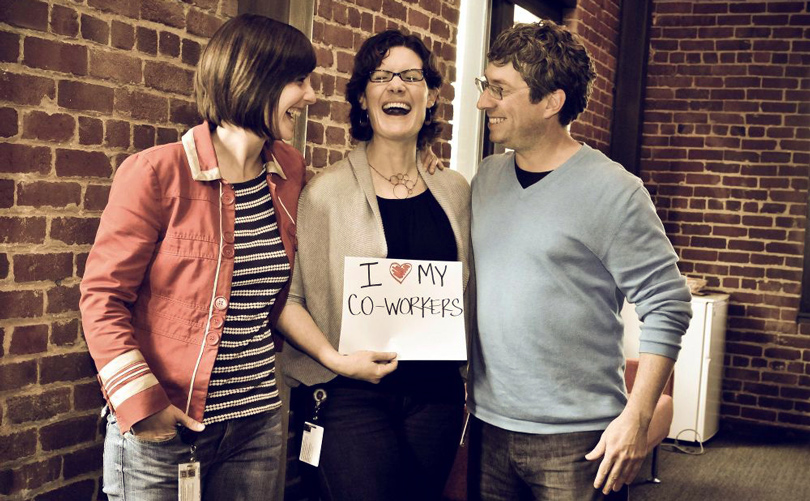Most wellness programs start with good intentions.
However, somewhere along the way, they veer off the right track. Many employers are so caught up in numbers that they feel the need to force employees to participate in their program. At first, incentives and disincentives do boost engagement numbers; however, it’s a short-term solution to a much larger problem. Forcing participating with heavy incentives can also be seen as overly coercive by employees. Plus, punishing workers for unhealthy behaviors can create an environment of shame and retribution – the precise opposite of wellness.
I believe that the real power lies in intrinsic motivation. It’s a much longer road, but the impact you can have is so much more rewarding. The best-designed wellness programs understand that wellness is extremely personal. Everyone has their own unique definition of being healthy – from yoga in the park to training for a marathon. Wellness programs that encourage employees to set specific goals that embody their personal or intrinsic motivation will have better results.
Recently, I had the opportunity to talk with Adobe’s Global Well-being Strategist Sara Torres. Adobe is one company who is doing wellness right. Adobe supports employees’ physical, emotional and financial well-being—so they can be the best at work and at home. You can check out the full interview here.
First, an important distinction for Adobe’s program is that they made the strategic decision to call their program a well-being program. “It sounds like a small thing, but we feel that wellness talks more solely to one’s physical aspects of health,” said Torres.
Adobe also has a defined mission statement that guides their entire program. Having a mission statement is a great way to clarify the intentions of your employee wellness program. Your wellness mission statement can also be used as a reference point. This helps to simplify your wellness strategy by defining a clear direction for your wellness program to go.
The Adobe mission statement provides clarity, direction and relatability: “Adobe Cares: Your Well-being Matters. We provide inclusive and holistic experiences to meet employees’ needs.” This philosophy has been adopted at a global level within the Adobe organisation and all of Adobe’s partners are striving towards this mission as well. It serves as the anchor for their philosophy.
Often companies feel a sense of urgency when creating a wellness program. Leaders may feel pressure to implement something quickly and find the first vendor with an extravagant portal that promises big results, but ultimately that strategy won’t work well for a company that has a global workforce. The Adobe team took their time and developed a thoughtful well-being program that to could be implemented across the globe.
According to Torres, “When we set out to build this program we started in the U.S. and then progressed globally. The employee was at the centre of our design.”
And that employee shifted as they moved across the globe, when they built out the U.S. program, that employee was as at the centre, and then when they moved to India, the India employee was in the centre.
“We have been successful at achieving global consistency and cultural relevance. We have the same mission, but as far as our focus areas, they are slightly different from region to region depending on the needs of employees in that area. That’s something I am really proud of because it made our program stronger and we put the employee first wherever they are in the world,” says Torres.
Another area companies struggle with is how to measure wellness program success. There is a lot of talk in the industry about return on investment or reducing health care costs, but Adobe takes a different approach.
“Our program is focused entirely on engagement rather than outcomes or incentives. We purposely stay away from financial incentives. What we are really trying to promote is intrinsic motivation and when you do the carrot and stick approach the behavior doesn’t really stick. It doesn’t become a habit.”
“We do measure participation but our program isn’t tied to our health plan. As a whole, we look at our well-being program as a culture maker, not a money saver. We look at our well-being program as a culture maker, not a money saver. We are trying to change the way employees think about their own health and well-being. We really encourage them to become excited, take control over it and jump into the resources we have. It’s harder to get people to care so we might not see as big as participation numbers as employers that give people money. But we are confident that once they do find that motivation that it’s more likely to stick,” says Torres.
So what does a well-being program who puts the employee at the centre really look like? Here is a breakout of some the opportunities for U.S. Adobe employees:
Physical Well-being
- Wellness Reimbursement Program: Reimbursement of up to $360 per year for gym memberships, bike share memberships, fitness classes, massages, nutritional counseling and more.
- Café: Provides healthy and delicious breakfasts, lunches and snacks in San Jose, San Francisco, Seattle and Lehi offices. The Adobe Well program encourages healthy choices in exchange for discounts on Wellness Centre massages. Plus, the cafés have a well-being indicator arrow that gives employees nutritional information.
- Fitbit Program: Subsidised pricing on select Fitbit wellness devices.
- Wellness Centres: A wide range of fitness equipment, group exercise classes, and services such as personal training, massages and free fitness assessments are available in the San Jose, San Francisco, Seattle and Lehi offices.
- Registered Dietitian Nutritionist: Free one-on-one nutritional coaching sessions.
- Onsite Biometric Screenings and Flu Shots: Employees can learn key health numbers and get a flu shot to stay healthy when flu season rolls around.
Emotional Well-being
- Employee Assistance Program: Confidential, short- term counseling services and additional work and life resources. Employees and dependents may use up to six free sessions per issue each year—in person, via live video or over the phone.
- Behavioral Health Support: In-person and video sessions available through the medical plan to provide ongoing support for anxiety, eating disorders, depression, family issues and more.
- Headspace Meditation App: Short, guided meditation sessions to help employees manage stress, sleep better, find focus, boost creativity and achieve more balance.
Financial Well-being
- Comprehensive Savings and Insurance Programs: All the programs you expect to help employees save for the future and provide a safety net in times of need, including a retirement plan, an employee stock purchase plan, a college savings plan, a Health Savings Account, and disability and life insurance.
- Extended Financial Resources and Coverage: Additional programs and services to help employees manage and protect money, including financial wellness coaching, budgeting tools, investment advice resources, identity theft protection, expert tax guidance and online tools, group legal services, long-term care insurance and more.
Your employees hold the answer to building a successful wellness program. Take the time to use surveys or focus groups to learn what they like about your wellness program, what they don’t like about your program, and what they want that you haven’t offered. Just remember to actually use their feedback after you get it.
If you take the time to really listen to your employees, find out what they need, and where they are on their wellness journey, you can create a tailor-made corporate wellness program that your employees will enjoy and want to participate in!
From: Forbes



